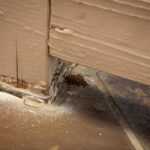Washington State is home to plenty of insects. As anyone who has ever traveled or lived here knows, there are plenty of trees, bushes, shrubs, and lots of flowers. Of course, those tend to attract bugs – especially during the summer months when it is warmer outside. With copious insects around the region, spiders are quite happy to set up a web and wait for those tasty treats. Unfortunately, this also means that there are venomous spiders in Washington.
One of the most significant is the black widow spider, known for its distinctive appearance and medically significant bites.
In particular, there are three species of poisonous spiders in Washington that you need to know.
Poisonous Spiders in Washington: Yes, We Have Black Widows
Typically associated with hotter climates, many people (especially those new to the region) are surprised to learn that black widows exist in Washington State. They are mostly in eastern Washington, but you can find a few of them on the western side too.
Black widows are famous for being venomous and for good reasons. Their bite is unpleasant at best and lethal at absolute worst. While these spider bites may not have a substantial death rate, that doesn’t mean they aren’t a health hazard. If a black widow bites you and injects you with venom, you’re looking at “severe pain, muscle cramping, abdominal pain, and back pain.” Black widow spider bites can cause significant medical issues, and it is crucial to seek medical attention if bitten, especially for vulnerable groups like children and the elderly.
The Western Black Widow Spider is particularly notable. It has distinct physical features, such as its shiny black color and red hourglass marking. The female’s venom is especially dangerous. These spiders tend to love hot, dry, dark places, near ground level. You’ll find them in firewood, basements, and in areas with clutter, where they build their webs in undisturbed areas.
Yellow Sac Spider
Another one of the poisonous spiders in Washington, the yellow sac spider is also in eastern Washington, but you will also find them in the Seattle area. These spiders don’t live in webs. Instead, they build small silk sacs in which they hide during the day.
These spiders live around gardens, woodpiles, and other places outside where they can hide. Then, when the weather cools off in the fall, these spiders make their way indoors, and that’s when you might see one dangling from the ceiling one day.
A yellow sac spider’s bite is not lethal (unless you have some severe allergy to this particular species). However, it is painful. The sore that develops will be ulcerative. It will typically take a few days or even a week to heal. So, while you will almost certainly live through the experience, it’s not one that you want!
Last, but Not Least of the Poisonous Spiders in Washington: Hobo Spider
The hobo spider is the most common poisonous one in Washington, as one can find it throughout the state. Fortunately, it’s also of the least concern in terms of bites or pain.
Hobo spiders are known for their distinctive funnel-shaped webs and are reluctant biters that usually try and escape. If you do receive a bite, you’ll typically have pain and maybe some swelling, but it won’t be as severe as a black widow or a yellow sac spider.
However, it is still poisonous, so it’s worth mentioning, given how common it is. And, of course, if you happen to have an allergy to this spider’s venom, then you may need to seek immediate medical attention!
Spider Bite Symptoms and Reactions
Understanding Symptoms and Reactions
Spider bites can cause a range of symptoms, from mild to severe. The severity of the reaction depends on the type of spider, the amount of venom injected, and the individual’s sensitivity. Common symptoms of a spider bite include:
- Pain or swelling at the bite site
- Redness or inflammation around the bite
- Itching or burning sensation
- Blisters or lesions
- Fever or chills
- Headache or nausea
In severe cases, spider bites can cause more serious reactions, such as:
- Anaphylaxis: a life-threatening allergic reaction that requires immediate medical attention
- Necrotic lesions: dead tissue that can lead to infection and scarring
- Systemic symptoms: symptoms that affect the entire body, such as fever, chills, and muscle pain
Your Best Prevention Against Bites Is to Remove the Spiders
Removing the spiders is your best prevention against bites. While it’s unlikely that bites from any of these spiders would result in death, they’re also not something you want to experience. A black widow’s venom, in particular, can impact you in other ways, even if you do survive it.
Wolf spiders are larger, quick hunters that do not spin webs and primarily hunt alone. They prefer habitats such as wooded areas and homes, using their physical characteristics and hunting methods to distinguish themselves from similar species.
As such, if you see any spiders around your home, your best bet is to have them professionally eliminated. With the right pest control solutions, you can ensure that your family remains free of unwanted pests, so neither you nor your loved ones have to experience the pain and anxiety resulting from a spider bite!
"*" indicates required fields
"*" indicates required fields




